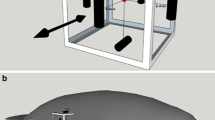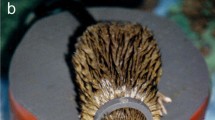Abstract
Florida manatees inhabit the coastal and inland waters of the peninsular state. They have little difficulty navigating the turbid waterways, which often contain obstacles that they must circumnavigate. Anatomical and behavioral research suggests that the vibrissae and associated follicle–sinus complexes that manatees possess over their entire body form a sensory array system for detecting hydrodynamic stimuli analogous to the lateral line system of fish. This is consistent with data highlighting that manatees are tactile specialists, evidenced by their specialized facial morphology and use of their vibrissae during feeding and active investigation/manipulation of objects. Two Florida manatees were tested in a go/no-go procedure using a staircase method to assess their ability to detect low-frequency water movement. Hydrodynamic vibrations were created by a sinusoidally oscillating sphere that generated a dipole field at frequencies from 5 to 150 Hz, which are below the apparent functional hearing limit of the manatee. The manatees detected particle displacement of less than 1 μm for frequencies of 15–150 Hz and of less than a nanometer at 150 Hz. Restricting the facial vibrissae with various size mesh openings indicated that the specialized sensory hairs played an important role in the manatee’s exquisite tactile sensitivity.





Similar content being viewed by others
Abbreviations
- BLH:
-
Bristle-like hair
- f:
-
Frequency (Hz)
- FA:
-
False alarm
- FSC:
-
Follicle–sinus complex
- MAR:
-
Minimum angle of resolution
References
Adibi M, Diamond ME, Arabzadeh E (2012) Behavioral study of whisker-mediated vibration sensation in rats. Proc Natl Acad Sci USA 109:971–976
Bachteler D, Dehnhardt G (1999) Active touch performance in the Antillean manatee: evidence for a functional differentiation of facial tactile hairs. Zoology 102:61–69
Bauer GB, Colbert DE, Gaspard JC, Littlefield B, Fellner W (2003) Underwater visual acuity of Florida manatees (Trichechus manatus latirostris). Int J Comp Psych 16:130–142
Bauer GB, Gaspard JC III, Colbert DE, Leach JB, Stamper SA, Mann D, Reep R (2012) Tactile discrimination of textures by Florida manatees (Trichechus manatus latirostris). Mar Mammal Sci doi: 10.1111/j.1748-7692.2012.00565.x
Bell CC (1982) Properties of a modifiable efference copy in an electric fish. J Neurophysiol 47:1043–1056
Catania KC, Kaas JH (1997) Somatosensory fovea in the star-nosed mole: behavioral use of the star in relation to innervation patterns and cortical representation. J Comp Neurol 387:215–233
Colbert D, Fellner W, Bauer GB, Manire CA, Rhinehart HL (2001) Husbandry and research training of two Florida manatees. (Trichechus manatus latirostris) Aquat Mamm 27:16–23
Colbert DE, Gaspard JC, Reep R, Mann DA, Bauer GB (2009) Four-choice sound localization abilities of two Florida manatees, Trichechus manatus latirostris. J Exp Biol 212(13):2105–2112
Coombs S, Janssen J (1989a) Peripheral processing by the lateral line system of the spotted sculpin (Cottus bairdi). In: Coombs S, Görner P, Munz H (eds) The mechanosensory lateral line system: neurobiology and evolution. Springer, Berlin Heidelberg New York, pp 299–319
Coombs S, Janssen J (1989b) Waterflow detection by the mechanosensory lateral line. In: Stebbins WC, Berkley M (eds) Comparative perception. John Wiley, New York, pp 89–123
Coombs S, Janssen J (1990) Behavioral and neurophysiological assessment of lateral line sensitivity in the mottled sculpin, Cottus bairdi. J Comp Physiol A 167:557–567
Coombs S, New JG, Nelson M (2002) Information-processing demands in electrosensory and mechanosensory lateral line systems. J Physiol 96:341–354
Cornsweet TN (1962) The staircase method in psychophysics. Am J Psychol 75:485–491
Crish S, Rice FL, Park T, Comer C (2003) Somatosensory organization and behavior in naked mole rats I: body vibrissae form a stereotyped sensory array that mediates orientation to tactile stimuli. Brain Behav Evol 62:141–152
Dehnhardt G (1994) Tactile size discrimination by a California sea lion (Zalophus californianus) using its mystacial vibrissae. J Comp Physiol 175:791–800
Dehnhardt G, Dücker G (1996) Tactile discrimination of size and shape by a California sea lion (Zalophus californianus). Ani Learn Beh 24:366–374
Dehnhardt G, Kaminski A (1995) Sensitivity of the mystacial vibrissae of harbor seals (Phoca vitulina) for size differences of actively touched objects. J Exp Biol 198:2317–2323
Dehnhardt G, Mauck B (2008) Mechanoreception in secondarily aquatic vertebrates. In: Thewissen JGM, Nummela S (eds) Sensory evolution on the threshold—adaptations in secondarily aquatic vertebrates. University of California Press, Berkely, pp 295–314
Dehnhardt G, Mauck B, Bleckmann H (1998) Seal whiskers detect water movements. Nature 394:235–236
Dehnhardt G, Hyvarinen H, Palviainen A, Klauer G (1999) Structure and innervation of the vibrissal follicle-sinus complex in the Australian water rat, Hydromys chrysogaster. J Comp Neurol 411:550–562
Dehnhardt G, Mauck B, Hanke W, Bleckmann H (2001) Hydrodynamic trail-following in harbor seals (Phoca vitulina). Science 293:102–104
Dykes RW (1975) Afferent fibers from mystacial vibrissae of cats and seals. J Neurophysiol 38:650–662
Ebara S, Kumamoto K, Matsuura T, Mazurkiewicz JE, Rice FL (2002) Similarities and differences of mystacial vibrissal follicle-sinus complexes in the rat and cat: a confocal microscopic study. J Comp Neurol 449:103–119
Fay FH (1982) Ecology and biology of the Pacific walrus Odobenus rosmarus divergens. USFWS North American Fauna 74, Washington, DC
Fay RR (1984) The goldfish ear codes the axis of acoustic particle motion in three dimensions. Science 225:951–954
Fay RR, Olsho LW (1979) Discharge patterns oflagenar and saccular neurons of the goldfish eighth nerve: displacement sensitivity and directional characteristics. Comp Biochem Physiol 62:377–386
Fay RR, Edds-Walton PL, Highstein SM (1994) Directional sensitivity of saccular afferents of the toadfish to linear acceleration at audio frequencies. Biol Bull 187:258–259
Gaspard JC III, Bauer GB, Reep RL, Dziuk K, Cardwell A, Read L, Mann DA (2012) Audiogram and auditory critical ratios of two Florida manatees (Trichechus manatus latirostris). J Exp Biol 215:1442–1447
Gerstein ER, Gerstein L, Forsythe SE, Blue JE (1999) The underwater audiogram of the West Indian manatee (Trichechus manatus). J Acoust Soc Am 105:3575–3583
Gescheider GA (1997) Psychophysics: the fundamentals. Lawrence Ehrlbaum Associates, Mahwah, NJ
Gläser N, Wieskotten S, Otter C, Dehnhardt G, Hanke W (2011) Hydrodynamic trail following in a California sea lion (Zalophus californianus). J Comp Physiol A 197:141–151
Hanke W, Witte M, Miersch L, Brede M, Oeffner J, Michael M, Hanke F, Leder A, Dehnhardt G (2010) Harbor seal vibrissa morphology suppresses vortex-induced vibrations. J Exp Biol 213:2665–2672
Hartman DS (1979) Ecology and behavior of the manatee (Trichechus manatus) in Florida. Am Soc Mamm Special Pub 5:1–153
Hassan ES (1989) Hydrodynamic imaging of the surroundings by the lateral line of the blind cave fish Anoptichthys jordani. In: Coombs S, Görner P, Münz H (eds) The mechanosensory lateral line. Neurobiology and evolution. Springer, Berlin, pp 217–227
Hyvärinen H (1995) Structure and function of the vibrissae of the ringed seal (Phoca hispida L.). In: Kastelein RA, Thomas JA, Nachtigall PE (eds) Sensory systems of aquatic mammals. De Spil Publishers, The Netherlands, pp 429–445
Kalmijn AJ (1988) Hydrodynamics and acoustic field detection. In: Atema J, Fay RR, Popper AN, Tavolga WN (eds) Sensory biology of aquatic animals. Springer, New York, pp 83–130
Kastelein RA, Van Gaalen MA (1988) The tactile sensitivity of the mystacial vibrissae of a Pacific walrus (Odobenus rosmarus divergens) Part 1. Aquatic Mamm 14:123–133
Lu Z, Popper AN, Fay RR (1996) Behavioral detection of acoustic particle motion by a teleost fish (Astronotus ocellatus): sensitivity and directionality. J Comp Physiol A 179:227–233
Mann DA, Colbert DE, Gaspard JC, Casper BM, Cook MLH, Reep RL, Bauer GB (2005) Auditory temporal resolution of the manatee (Trichechus manatus latirostris) auditory system. J Comp Physiol A 191:903–908
Marshall CD, Reep RL (1995) Manatee cerebral cortex: cytoarchitecture of the caudal region in Trichechus manatus latirostris. Brain Behav Evol 45:1–18
Marshall CD, Huth GD, Edmonds VM, Halin DL, Reep RL (1998) Prehensile use of perioral bristles during feeding and associated behaviors of the Florida manatee (Trichechus manatus latirostris). Mar Mammal Sci 14:274–289
Marshall CD, Amin H, Kovacs KM, Lydersen C (2006) Microstructure and innervation of the mystacial vibrissal follicle-sinus complex in bearded seals, Erignathus barbatus (Pinnipedia: Phocidae). Anat Rec A 288:13–25
Mass AM, Odell DK, Ketten DR, Supin AY (1997) Ganglion layer topography and retinal resolution of the Caribbean manatee (Trichechus manatus latirostris). Dokl Biol Sci 355:392–394
Mass AM, Ketten DR, Odell DK, Supin AY (2012) Ganglion cell distribution and retinal resolution in the Florida manatee, Trichechus manatus latirostris. Anat Rec 295:177–186
Reep RL, Johnson JI, Switzer RC, Welker WI (1989) Manatee cerebral cortex: cytoarchitecture of the frontal region in Trichechus manatus latirostris. Brain Behav Evol 34:365–386
Reep RL, Marshall CD, Stoll ML, Whitaker DM (1998) Distribution and innervation of facial bristles and hairs in the Florida manatee (Trichechus manatus latirostris). Mar Mammal Sci 14:257–273
Reep RL, Stoll ML, Marshall CD, Homer BL, Samuelson DA (2001) Microanatomy of facial vibrissae in the Florida manatee: the basis for specialized sensory function and oripulation. Brain Behav Evol 58:1–14
Reep RL, Marshall CD, Stoll ML (2002) Tactile hairs on the postcranial body in Florida manatees: a mammalian lateral line? Brain Behav Evol 59:141–154
Rice FL, Mance A, Munger BL (1986) A comparative light microscopic analysis of the sensory innervation of the mystacial pad. I. Innervation of the vibrissal follicle-sinus complexes. J Comp Neurol 252:154–174
Rice FL, Fundin BT, Arviddson J, Aldskogius H, Johansson O (1997) Comprehensive immunoflorescence and lectin binding analysis of vibrissal follicle sinus complex innervation in the mystacial pad of the rat. J Comp Neurol 385:149–184
Sarko DK, Reep RL, Mazurkiewicz JE, Rice FL (2007) Adaptations in the structure and innervation of follicle-sinus complexes to an aquatic environment as seen in the Florida manatee (Trichechus manatus latirostris). J Comp Neurol 504:217–237
Schulte-Pelkum N, Wieskotten S, Hanke W, Dehnhardt G, Mauck B (2007) Tracking of biogenic hydrodynamic trails in harbour seals (Phoca vitulina). J Exp Biol 210:781–787
Sokolov VE, Kulikov VF (1987) The structure and function of the vibrissal apparatus in some rodents. Mammalia 51:125–138
von Campenhausen C, Riess I, Weissert R (1981) Detection of stationary objects in the blind cave fish Anoptichthys jordani (Characidae). J Comp Physiol A 143:369–374
Weissert R, von Campenhausen C (1981) Discrimination between stationary objects by the blind cave fish Anoptichthys jordani. J Comp Physiol A 143:375–382
Zelena J (1994) Nerves and mechanoreceptors. Chapman and Hall, London
Acknowledgments
The authors would like to thank the United States Fish and Wildlife Service (Permit MA837923-6/7); the Florida Fish and Wildlife Conservation Commission; University of Florida, College of Veterinary Medicine—Aquatic Animal Health Program; Mote Marine Laboratory staff, interns, volunteers, especially trainer Jann Warfield, that assisted with this research; Guido Dehnhardt and Wolf Hanke for their expertise and equipment loan during training; Ronnie and John Enander; the Thurell family; New College of Florida students; Peg Scripps Buzzelli Chair, New College Foundation. This work was supported by the National Science Foundation (IOS-0920022/0919975/0920117). All experimental procedures were approved by the Mote Marine Laboratory IACUC prior to implementation.
Author information
Authors and Affiliations
Corresponding author
Rights and permissions
About this article
Cite this article
Gaspard, J.C., Bauer, G.B., Reep, R.L. et al. Detection of hydrodynamic stimuli by the Florida manatee (Trichechus manatus latirostris). J Comp Physiol A 199, 441–450 (2013). https://doi.org/10.1007/s00359-013-0822-x
Received:
Revised:
Accepted:
Published:
Issue Date:
DOI: https://doi.org/10.1007/s00359-013-0822-x




